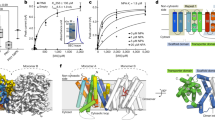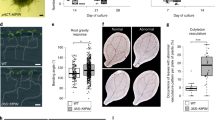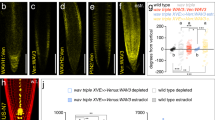Abstract
The plant signalling molecule auxin provides positional information in a variety of developmental processes by means of its differential distribution (gradients) within plant tissues1. Thus, cellular auxin levels often determine the developmental output of auxin signalling. Conceptually, transmembrane transport and metabolic processes regulate the steady-state levels of auxin in any given cell2,3. In particular, PIN auxin-efflux-carrier-mediated, directional transport between cells is crucial for generating auxin gradients2,4,5. Here we show that Arabidopsis thaliana PIN5, an atypical member of the PIN gene family, encodes a functional auxin transporter that is required for auxin-mediated development. PIN5 does not have a direct role in cell-to-cell transport but regulates intracellular auxin homeostasis and metabolism. PIN5 localizes, unlike other characterized plasma membrane PIN proteins, to endoplasmic reticulum (ER), presumably mediating auxin flow from the cytosol to the lumen of the ER. The ER localization of other PIN5-like transporters (including the moss PIN) indicates that the diversification of PIN protein functions in mediating auxin homeostasis at the ER, and cell-to-cell auxin transport at the plasma membrane, represent an ancient event during the evolution of land plants.
This is a preview of subscription content, access via your institution
Access options
Subscribe to this journal
Receive 51 print issues and online access
$199.00 per year
only $3.90 per issue
Buy this article
- Purchase on Springer Link
- Instant access to full article PDF
Prices may be subject to local taxes which are calculated during checkout




Similar content being viewed by others
References
Vanneste, S. & Friml, J. Auxin: trigger of change in plant development. Cell 136, 1005–1016 (2009)
Vieten, A., Sauer, M., Brewer, P. B. & Friml, J. Molecular and cellular aspects of auxin-transport-mediated development. Trends Plant Sci. 12, 160–168 (2007)
Woodward, A. W. & Bartel, B. Auxin: regulation, action, and interaction. Ann. Bot. (Lond.) 95, 707–735 (2005)
Kramer, E. M. & Bennett, M. J. Auxin transport: a field in flux. Trends Plant Sci. 11, 382–386 (2006)
Bandyopadhyay, A. et al. Interactions of PIN and PGP auxin transport mechanisms. Biochem. Soc. Trans. 35, 137–141 (2007)
Petrášek, J. et al. PIN proteins perform a rate-limiting function in cellular auxin efflux. Science 312, 914–918 (2006)
Wiśniewska, J. et al. Polar PIN localization directs auxin flow in plants. Science 312, 883 (2006)
Friml, J. et al. Efflux-dependent auxin gradients establish the apical-basal axis of Arabidopsis . Nature 426, 147–153 (2003)
Benková, E. et al. Local, efflux-dependent auxin gradients as a common module for plant organ formation. Cell 115, 591–602 (2003)
Reinhardt, D. et al. Regulation of phyllotaxis by polar auxin transport. Nature 426, 255–260 (2003)
Friml, J. et al. AtPIN4 mediates sink driven auxin gradients and root patterning in Arabidopsis . Cell 108, 661–673 (2002)
Blilou, I. et al. The PIN auxin efflux facilitator network controls growth and patterning in Arabidopsis roots. Nature 433, 39–44 (2005)
Scarpella, E., Marcos, D., Friml, J. & Berleth, T. Control of leaf vascular patterning by polar auxin transport. Genes Dev. 20, 1015–1027 (2006)
Xu, J. et al. A molecular framework for plant regeneration. Science 311, 385–388 (2006)
Sauer, M. et al. Canalization of auxin flow by Aux/IAA-ARF-dependent feedback regulation of PIN polarity. Genes Dev. 20, 2902–2911 (2006)
Luschnig, C., Gaxiola, R. A., Grisafi, P. & Fink, G. R. EIR1, a root-specific protein involved in auxin transport, is required for gravitropism in Arabidopsis thaliana . Genes Dev. 12, 2175–2187 (1998)
Friml, J., Wiśniewska, J., Benková, E., Mendgen, K. & Palme, K. Lateral relocation of auxin efflux regulator PIN3 mediates tropism in Arabidopsis . Nature 415, 806–809 (2002)
Vieten, A. et al. Functional redundancy of PIN proteins is accompanied by auxin-dependent cross-regulation of PIN expression. Development 132, 4521–4531 (2005)
Zhao, Y. et al. A role for flavin monooxygenase-like enzymes in auxin biosynthesis. Science 291, 306–309 (2001)
Geldner, N., Friml, J., Stierhof, Y.-D., Jürgens, G. & Palme, K. Auxin transport inhibitors block PIN1 cycling and vesicle trafficking. Nature 413, 425–428 (2001)
Kleine-Vehn, J. et al. ARF GEF-dependent transcytosis mechanism for polar delivery of PIN auxin carriers in Arabidopsis . Curr. Biol. 18, 526–531 (2008)
Bartel, B. & Fink, G. R. ILR1, an amidohydrolase that releases active indole-3-acetic acid from conjugates. Science 268, 1745–1748 (1995)
Maeshima, M. & Ishikawa, F. ER membrane aquaporins in plants. Pflugers Arch. 456, 709–716 (2008)
Ohno, H. et al. Interaction of tyrosine-based sorting signals with clathrin-associated proteins. Science 269, 1872–1875 (1995)
Rensing, S. A. et al. The Physcomitrella genome reveals evolutionary insights into the conquest of land by plants. Science 319, 64–69 (2008)
Kepinski, S. & Leyser, O. The Arabidopsis F-box protein TIR1 is an auxin receptor. Nature 435, 446–451 (2005)
Dharmasiri, N., Dharmasiri, S. & Estelle, M. The F-box protein TIR1 is an auxin receptor. Nature 435, 441–445 (2005)
Jones, A. M. & Herman, E. M. KDEL-containing auxin-binding protein is secreted to the plasma membrane and cell wall. Plant Physiol. 101, 595–606 (1993)
Chen, J., Ullah, H., Young, J. C., Sussman, M. R. & Jones, A. M. ABP1 is required for organized cell elongation and division in Arabidopsis embryogenesis. Genes Dev. 15, 902–911 (2001)
Fujita, T. et al. Convergent evolution of shoots in land plants: lack of auxin polar transport in moss shoots. Evol. Dev. 10, 176–186 (2008)
Hellens, R. P. et al. pGreen: a versatile and flexible binary Ti vector for Agrobacterium-mediated plant transformation. Plant Mol. Biol. 42, 819–832 (2000)
Karimi, M., Inze, D. & Depicker, A. Gateway vectors for Agrobacterium-mediated plant transformation. Trends Plant Sci. 7, 193–195 (2002)
Aoyama, T. & Chua, N.-H. A glucocorticoid-mediated transcriptional induction system in transgenic plants. Plant J. 11, 605–612 (1997)
Weijers, D., Van Hamburg, J. P., Van Rijn, E., Hooykaas, P. J. & Offringa, R. Diphtheria toxin-mediated cell ablation reveals interregional communication during Arabidopsis seed development. Plant Physiol. 133, 1882–1892 (2003)
Bouchard, R. et al. Immunophilin-like TWISTED DWARF1 modulates auxin efflux activities of Arabidopsis P-glycoproteins. J. Biol. Chem. 281, 30603–30612 (2006)
Nagata, T., Nemoto, Y. & Hasezawa, S. Tobacco BY-2 cell line as the “HeLa” cell in the cell biology of higher plants. Int. Rev. Cytol. 132, 1–30 (1992)
Dobrev, P. & Kamínek, M. Fast and efficient separation of cytokinins from auxin and abscisic acid and their purification using mixed-mode solid-phase extraction. J. Chromatogr. A. 950, 21–29 (2002)
Tommasini, R. et al. The human multidrug resistance-associated protein functionally complements the yeast cadmium resistance factor 1. Proc. Natl Acad. Sci. USA 93, 6743–6748 (1996)
Geisler, M. et al. TWISTED DWARF1, a unique plasma membrane-anchored immunophilin-like protein, interacts with Arabidopsis multidrug resistance-like transporters AtPGP1 and AtPGP19. Mol. Biol. Cell 14, 4238–4249 (2003)
Hejátko, J. et al. In situ hybridisation technique for mRNA detection in whole mount Arabidopsis samples. Nature Protocols 1, 1462–1467 (2006)
Sauer, M., Paciorek, T., Benková, E. & Friml, J. Immunocytochemical techniques for whole-mount in situ protein localization in plants. Nature Protocols 1, 98–103 (2006)
Bar-Peled, M. & Raikhel, N. V. Characterization of AtSEC12 and AtSAR1. Proteins likely involved in endoplasmic reticulum and Golgi transport. Plant Physiol. 114, 315–324 (1997)
Li, Q. et al. A syntaxin 1, Gαo, and N-type calcium channel complex at a presynaptic nerve terminal: analysis by quantitative immunocolocalization. J. Neurosci. 24, 4070–4081 (2004)
Manders, E. E. M., Verbeek, F. J. & Aten, J. A. Measurement of co-localisation of objects in dualcolour confocal images. J. Microsc. 169, 375–382 (1993)
Katoh, K., Misawa, K., Kuma, K. & Miyata, T. MAFFT: a novel method for rapid multiple sequence alignment based on fast Fourier transform. Nucleic Acids Res. 30, 3059–3066 (2002)
Ronquist, F. & Huelsenbeck, J. P. MrBayes 3: Bayesian phylogenetic inference under mixed models. Bioinformatics 19, 1572–1574 (2003)
Acknowledgements
We thank D. G. Robinson, J. Clarke and NASC for providing material; B. Scheres and H. Höfte for sharing unpublished data, E. Bellinvia, M. Pařezová, B. Pešek and V. Vincenzetti for technical help and M. De Cock for critical reading and help with preparing the manuscript. This work was supported by the Volkswagenstiftung (J.F., J.M., V.G.), the Odysseus programme of the FWO (J.M., J.Z.), GA ASCR IAA601630703 (J.F.) and KJB600380604 (J.P., K.S.), the Ministry of Education, Youth and Sports of the Czech Republic, project number LC06034 (E.Z., P.S., P.K., K.H., J.P., D.S.) and MSM6198959216 (J.R.), a European Research Council starting independent research grant to E.B. (A.Bi.), the Novartis Foundation (M.G.), the Swiss National Funds (M.G.), the Forschungskredit of the University of Zurich (A.Ba.) and the Austrian Science Fund (C.L).
Author Contributions J.F. and J.M. designed the research. J.M. cloned the constructs, established the mutants and performed the expression and localization analyses, P.S. designed and performed metabolic profiling, and established transgenic tobacco lines, A.Ba. and M.G. performed the transport assays in yeast and protoplasts, K.H. performed the free IAA measurements, P.I.D. and J.R. ran HPLC and MS auxin analyses, J.P. and K.S. analysed localization of PINs in BY-2 tobacco cells, D.S. prepared PIN6-GFP construct, A.Bi. and E.B. performed the analysis of the lateral root phenotypes, J.Z. performed the site-directed mutagenesis, V.G. performed the phenotype analyses, Y.-D.S. performed the electron microscopy, C.L. originally identified the PIN5 gene, isolated the PIN5 cDNA and generated overexpression lines, J.F. performed the in situ hybridization, P.K. constructed the cladogram, and J.M., E.Z. and J.F. wrote the manuscript.
Author information
Authors and Affiliations
Corresponding author
Supplementary information
Supplementary Information
This file contains Supplementary Figures 1-10 with Legends and Supplementary References. (PDF 2566 kb)
Rights and permissions
About this article
Cite this article
Mravec, J., Skůpa, P., Bailly, A. et al. Subcellular homeostasis of phytohormone auxin is mediated by the ER-localized PIN5 transporter. Nature 459, 1136–1140 (2009). https://doi.org/10.1038/nature08066
Received:
Accepted:
Published:
Issue Date:
DOI: https://doi.org/10.1038/nature08066
This article is cited by
-
Genome-wide analysis of PIN genes in cultivated peanuts (Arachis hypogaea L.): identification, subcellular localization, evolution, and expression patterns
BMC Genomics (2023)
-
Transcriptomic analysis implicates ABA signaling and carbon supply in the differential outgrowth of petunia axillary buds
BMC Plant Biology (2023)
-
PIN5 is involved in regulating NH4+ efflux and primary root growth under high-ammonium stress via mediating intracellular auxin transport
Plant and Soil (2023)
-
Full-length transcriptome and metabolism revealed the difference of callus formation of tea cutting under white, red and blue light
Plant Growth Regulation (2023)
-
Auxin regulation on crop: from mechanisms to opportunities in soybean breeding
Molecular Breeding (2023)
Comments
By submitting a comment you agree to abide by our Terms and Community Guidelines. If you find something abusive or that does not comply with our terms or guidelines please flag it as inappropriate.



